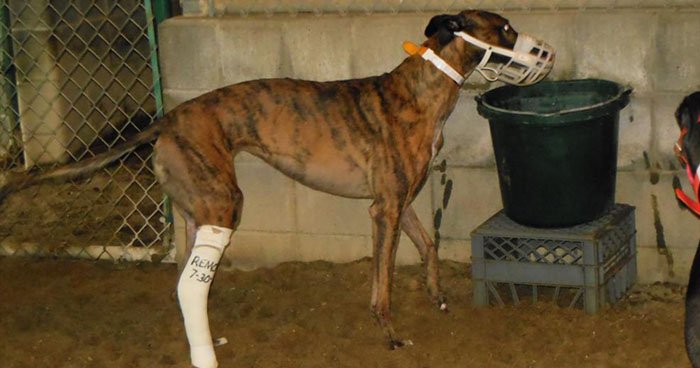RACE TO DEATH
Since the time of the ancient Egyptians, people have benefited from the innate elegance and speed of greyhounds. Although the dogs have been employed in hunting and coursing activities for generations, the introduction of modern dog racing at the turn of the 20th century caused breeders and owners of racetracks to start viewing this breed as a mere commodity. Finally, the industry's cruelty is coming to light, and as a result of the uproar that followed, fewer people are now watching greyhound races. In the states that still permit it, greyhound racing continues to produce millions of dollars in gambling income.
Commercial greyhound racing exists in seven countries at 115 tracks worldwide. It was first developed in the United States, and it is often distinguished by a regulatory body, state-approved gambling, an industrialized breeding apparatus, a method of identification for greyhounds through tattoos, structured kennel operations, and a network of public racetracks. The United States, Australia, Ireland, Mexico, New Zealand, the United Kingdom, and Vietnam presently allow dog racing. Commercial racing is prohibited in several states, most recently Oregon in the United States, even inside these jurisdictions. Non-commercial dog racing is also known to exist in twenty-one countries.
Every year, the greyhound business produces at least 7,000 greyhound litters for the express purpose of gambling. This equates to at least 42,000 greyhound puppies annually, without accounting for the thousands that go unnamed and are not included in industry record keeping. Though not every jurisdiction operates in the same way, racing greyhounds are subjected to cruel and inhumane practices such as confinement, major racing injuries, and the danger of "culling" at every stage of life. The majority of racing greyhounds are bred in Ireland, Australia, and the United States, respectively.
The majority of greyhounds used for commercial racing live in horrible confinement. Dogs are kept in warehouse-style kennels, side by side, or in stacked cages in jurisdictions such as the United States. They are confined for lengthy periods of time each day, with bedding ranging from carpet remnants and shredded newspaper to burlap bags.
Greyhounds are regularly injured at dog racetrack across the world. Only a few governments, nevertheless, routinely provide injury statistics. Upon request from the public, the racing commissions of the American states of Arkansas and West Virginia provide injury statistics. In 2015, 2016, and 2018, respectively, the Australian states of New South Wales, Tasmania, Western Australia, and Queensland began reporting injury statistics. New Zealand started doing so in 2020, while Ireland started reporting injury statistics in 2015. Broken legs, skull fractures, convulsions, paralysis, broken backs, and electrocution deaths are just a few of the reported wounds.
From 2016 to 2021, 33,537 injuries were documented in Australia, while 15,384 greyhounds were declared deceased by the industry. Tracks in the United Kingdom were not required to make injury information public until 2017, but GREY2K USA Worldwide conducted an analysis of injury information obtained from the social media accounts of leading industry members. A total of 276 specific greyhound injuries dating from 2006 to June 2014 could be documented. As in other racing jurisdictions, bone fractures were overwhelmingly the most frequently reported injury. The Greyhound Board of Great Britain’s 2021 reports identified 22,767 injuries, including 2,166 greyhounds killed due to injury. In Ireland, between 2015 and 2020, 2,146 injuries were documented, including 715 track fatalities. New Zealand published injury data for the first time in 2021 and identified 900 injuries during the financial year. From 2014 through 2021, 2,571 greyhounds were reported dead. Mexico and Vietnam do not publish injury data.
Death is an all-too-common outcome for racing greyhounds. The racing pool is emptied of dogs who are too slow or have significant injuries. In the best case scenario, this circumstance may lead to physical rehabilitation and adoption, but all too frequently dog owners and trainers just put undesirable canines to death. The worldwide commercial racing industry has a well-documented history of animal welfare issues and abuse. These include starvation, drugging, mutilation, and abandonment.
Greyhounds frequently test positive for harmful, illegal substances. Doping agents such as cocaine, EPO, morphine, and amphetamines are often detected in greyhounds. Despite the fact that the industry sometimes blames these incidents on contaminated food or the misdeeds of a few individuals, doping is a serious issue in the racing community. Nearly 900 illegal substances are included on the Association of Racing Commissioners International's official control list, an organization that aims to ensure integrity in the horse- and greyhound-racing industry.
The greyhound racing business is in trouble. Numerous tracks have closed and are still closing all around the world. There are now less than 120 commercial tracks, and more are expected to close soon. Due to growing public awareness of how cruel and inhumane dog racing is, along with competition from new, quicker forms of gambling like internet betting, dog racing has been on the decline. Since GREY2K USA Worldwide began its US campaign in 2001, forty-six American dog tracks have closed or ceased live racing. Once numbering over 100, Australia’s tracks have continued to close. Today, the country has sixty- four greyhound tracks, the most recent one closing in April 2018. New Zealand once operated thirteen tracks and now maintains only seven. The UK once had at least seventy-seven licensed tracks. Now only twenty-two operate there, with Poole having closed in August 2020. In China, the Canidrome was ordered to close by the Macau government In July 2018. This was the only legal dog track in the entire country. Greyhound racing and its attendant cruelties violate the values of our world community and should be prohibited.





